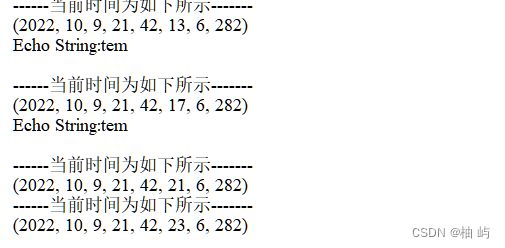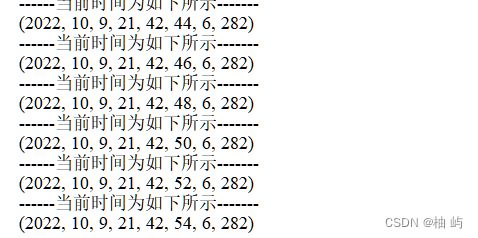- STM32入门之TIM基本定时器
嵌入式白话
STM32入门学习stm32嵌入式硬件单片机
一、定时器简介定时器是嵌入式系统中的关键外设之一,它可以用于生成精确的延时、周期性中断、PWM波形生成等功能。在STM32F1系列单片机中,定时器不仅能为系统提供精确的时钟,还支持外部事件的捕获以及信号输出。对于定时器的功能,我们可以通过一个生活中非常常见的例子来形象地描述:微波炉的定时器。想象你正在使用微波炉加热食物。在微波炉里,定时器的作用就是帮助你控制食物加热的时间。当你设置了加热时间后,定
- 基于STM32的智能鱼缸设计
DS小龙哥
智能家居与物联网项目实战stm32单片机arm
1.前言为了缓解学习、生活、工作带来的压力,提升生活品质,许多人喜欢在家中、办公室等场所养鱼。为节省鱼友时间、劳力、增加养鱼乐趣;为此,本文基于STM32单片机设计了一款智能鱼缸。该鱼缸可以实现水温检测、水质检测、自动或手动换水、氛围灯灯光变换和自动或手动喂食等功能为一体的控制系统,可通过控制键进行一键控制。从功能上分析,需要用到的硬件如下:(1)STM32系统板(2)水温温度检测传感器:测量水温
- 【利用51单片机的定时器功能产生PWM信号来实现流水呼吸灯。(蓝桥杯常考PWM)】
CrimsonEmber
蓝桥杯51单片机单片机
题目要求:[1]上电开机运行时,关闭蜂鸣器和继电器,L4和L5点亮,其余LED灯熄灭。[2]点按独立按键S4松开后,开始控制CT107D板上的L1-L8八个LED小灯进行每隔1秒的呼吸流水点亮,即:L1缓慢亮->L1缓慢灭->L2缓慢亮->L2缓慢灭....L8缓慢亮->L8缓慢灭->L1缓慢亮->L1缓慢灭....循环往复。[3]再次点按独立按键S4松开后,控制CT107D板上的LED灯从当前灯
- 嵌入式硬件篇---ESP32稳压板
Atticus-Orion
嵌入式知识篇嵌入式硬件篇嵌入式硬件ESP32稳压板
制作ESP32稳压板的核心目标是:给ESP32提供稳定的3.3V电源(ESP32的工作电压必须是3.3V),同时支持多种供电方式(比如锂电池、USB、外接电源),并具备保护功能(防止过流、接反电源等)。整个流程和搭积木类似,一步步把“供电→稳压→保护→输出”这几个模块拼起来,新手也能看懂。一、先明确:你的稳压板要实现什么功能?在动手前,先想清楚这3个问题(直接决定电路设计):输入电源类型:打算用什
- 嵌入式硬件篇---有线串口通信问题
Atticus-Orion
嵌入式知识篇嵌入式硬件篇嵌入式硬件有线串口TTLRS232RS485
有线串口通信(通常指UART/RS-232/RS-485等)虽然相比无线通信更稳定,但仍可能出现接收异常(如丢包、乱码、无响应),其原因涉及物理连接、电气特性、协议配置、硬件性能等多个层面。以下从具体机制展开详细分析:一、物理连接与线路问题有线通信的核心依赖物理线路传输电信号,线路的完整性和连接质量直接影响信号传输,是接收异常的最常见原因。1.线路接触不良或断线引脚接触问题:串口连接器(如DB9插
- STM32Cube HAL库——串口通讯(蓝牙)
北辰远_code
STM32CubeHAL库学习教程stm32嵌入式硬件单片机
STM32CubeHAL库——串口通讯(蓝牙)这篇文章是为了接下来将要进行的项目做一个铺垫,串口通讯可以实时查看参数,让我们在项目中事半功倍。一、串口通讯基本知识串口通讯基本知识网上资料非常多,小编不再过多赘述,详细请查看STM32通信基本知识串口通信(USART)。二、STM32CubeMX配置****本例中依旧使用单片机STM32F405,蓝牙传输使用逐飞蓝牙透传模块。由于在很多STM32项目
- STM32F411与RT-Thread实时操作系统:定时器功能实现
本文还有配套的精品资源,点击获取简介:本项目详细介绍了如何在STM32F411单片机上利用RT-Thread实时操作系统实现硬件定时器功能。STM32F411是高性能、低功耗的Cortex-M4内核微控制器,而RT-Thread提供了一个轻量级、功能丰富的实时操作系统环境,适用于物联网设备。本文档涵盖了通用定时器和高级定时器的不同配置和使用方法,并强调了中断优先级配置、资源冲突解决、定时精度选择和
- 单片机的硬件结构
Hallin_Me
单片机嵌入式硬件
单片机的硬件结构一、课程导入在上一节课《认识单片机》中,我们知道单片机就像一个超级迷你的工厂,有着类似工厂的各个组成部分。而这个“迷你工厂”能正常运转,离不开其内部严谨的硬件结构。就像一座大厦,只有基础结构稳固且各部分配合得当,才能屹立不倒。本节课我们就来深入剖析单片机的硬件结构,看看这个“迷你工厂”的“建筑结构”到底是怎样的。二、单片机硬件结构整体框架单片机的硬件结构是一个有机的整体,各个部分相
- 单片机OTA中的Y Modem传输协议深度解析
硬核科技
嵌入式单片机开发实战单片机嵌入式硬件零基础嵌入式软件OTA通信协议
随着物联网设备及嵌入式产品的迭代升级,OTA(Over-The-Air)固件升级已成为单片机系统的常见功能。对于资源受限的MCU,串口仍是最普遍的固件传输通道。在多种串口文件传输协议中,YModem协议因其效率和稳定性而被广泛采用,特别是在瑞萨RX系列、STM32、NXP等MCU的Bootloader设计中有较多应用。1.XModem到YModem1.1协议基础XModem协议:早期串口文件传输协
- 51单片机——串口通信
1、串口简介串口是一种应用十分广泛的通讯接口,串口成本低、容易使用、通信线路简单,可实现两个设备的互相通信。单片机的串口可以使单片机与单片机、单片机与电脑、单片机与各式各样的模块互相通信,极大的扩展了单片机的应用范围,增强了单片机系统的硬件实力。51单片机内部自带UART(UniversalAsynchronousReceiverTransmitter,通用异步收发器),可实现单片机的串口通信。2
- 单片机开发中C语言的结构体(struct)与C++的类(class)之间的区别、使用场景,并通过实例进行对比说明。
承接电子控制项目开发
单片机c语言c++
单片机开发中C语言的结构体(struct)与C++的类(class)之间的区别、使用场景,并通过实例进行对比说明。理解这些差异对于在资源受限的单片机环境中选择合适的编程范式至关重要。核心概念1.C语言结构体(struct):◦本质:一种数据聚合机制。它将多个不同类型的数据项(成员变量)组合成一个单一的、逻辑上的单元。核心功能:组织相关数据,提高代码可读性和可维护性。它定义了一个数据结构。关键限制:
- 【电赛学习笔记】MaxiCAM 项目实践——与单片机的串口通信
悠哉悠哉愿意
电赛学习记录学习笔记单片机python视觉检测嵌入式硬件
前言本文是对视觉模块和STM32如何进行串口通信_哔哩哔哩_bilibili大佬的项目实践与拓展实现与mspm0g3507的串口通信,侵权即删。MaxiCAM与STM32串口通信实践串口协议数据传输importstruct'''协议数据格式:帧头(0xAA)+数据域长度+数据域+长度及数据域数据和校验+帧尾(0x55)'''classSerialProtocol():HEAD=0xAATAIL=0
- 嵌入式硬件篇---驱动板
Atticus-Orion
嵌入式硬件篇嵌入式知识篇嵌入式硬件单片机ESP32驱动板
制作ESP32驱动板的核心是“搭建ESP32与外设之间的桥梁”——因为ESP32的GPIO引脚输出电流很小(最大20mA),无法直接驱动大功率设备(如电机、继电器、电磁阀等),驱动板的作用就是放大电流/功率,同时将ESP32的弱电信号(3.3V)转换成外设能识别的信号,让外设按ESP32的指令工作。一、先明确:你要驱动什么外设?驱动板的设计完全取决于“要控制的外设”,不同外设需要的驱动电路差异很大
- 嵌入式硬件篇---zigbee无线串口通信问题
Atticus-Orion
嵌入式硬件篇嵌入式知识篇嵌入式硬件无线串口zigbee
使用ZigBee进行无线串口通信时,接收异常(如丢包、乱码、完全无法接收)是常见问题,其原因涉及射频通信特性、网络机制、硬件配置、环境干扰等多个层面。以下从具体机制出发,详细分析可能的原因:一、射频层干扰与信号衰减ZigBee工作在2.4GHzISM公用频段(部分地区支持868/915MHz),该频段开放性强,易受干扰;同时无线信号的传播特性也会直接影响接收稳定性。同频干扰2.4GHz频段被Wi-
- 嵌入式硬件篇---有线串口通信问题解决
Atticus-Orion
嵌入式硬件篇嵌入式知识篇嵌入式硬件单片机有线串口TTLRS232RS485
有线串口通信(如RS-232、RS-485、TTL-UART)的接收问题往往涉及物理连接、电气特性、参数配置等多个环节,解决时需按“分层排查、逐步验证”的思路,结合工具定位问题并针对性处理。以下是详细的解决方法:一、解决物理连接与线路问题物理层是通信的基础,优先排除线路接触不良、布线干扰等问题。1.修复接触不良与断线检查连接器与接线:对DB9插头、端子排等连接部件,重新插拔或紧固螺丝,去除氧化层(
- 单片机C51使用两个按键控制继电器开关通断
小泡泡避难所
51单片机学习笔记
本教程实现了使用89C51控制按键开关,通过继电器间接控制380v交流电的通断,进而控制空调的电流的通断,实现节能减排的功效。使用1个继电器开关botton1控制继电器开的状态,1个继电器开关botton2控制继电器闭的状态。button1通过单片机P1_3管脚控制,进而控制继电器D1两端电压高低的变化,进而实现交流电的导通状态。button2通过单片机P1_4管脚控制,给按一次实现继电器D1两端
- KiCad 与 CircuitMaker 使用方法分享:从零开始学电子设计
Hy行者勇哥
#硬件知识物联网嵌入式硬件
摘要本文档专为电子设计新手打造,详细介绍了两款主流免费电子设计自动化(EDA)软件——KiCad和CircuitMaker的使用方法。内容涵盖软件安装、项目创建、原理图绘制、PCB布局及生产文件导出等完整流程,通过step-by-step操作步骤和实用技巧,帮助零基础用户快速掌握电子电路设计的基本技能,适用于单片机、嵌入式系统等小型电子项目的开发。一、软件简介与适用场景1.KiCad特点:完全开源
- 嵌入式软硬件及软件平台开发入门指南:知识、工具与 AI 辅助
Hy行者勇哥
#硬件知识人工智能单片机嵌入式硬件
摘要本文专为零基础小白整理嵌入式软硬件及软件平台开发的核心知识点、必备工具,以及借助AI大模型快速入门的方法。内容涵盖硬件设计、软件开发、平台搭建的关键知识框架,推荐小白友好型工具,并通过PlantUML知识图谱和工具图谱可视化呈现,帮助小白清晰掌握学习路径,快速进入开发者角色。一、核心知识点框架(一)嵌入式硬件开发核心知识电路基础必备概念:电压、电流、电阻、电容的基本作用;串联/并联电路特性;欧
- 电子信息工程专业学生的就业方向
祝老师
学习之外电子就业职场应用
如果从工程师和研究生的专业方向来看,电子信息专业的方向大概有1)数字电子线路方向。从事单片机(8位的8051系列、32位的ARM系列等等)、FPGA(CPLD)、数字逻辑电路、微机接口(串口、并口、USB、PCI)的开发,更高的要求会写驱动程序、会写底层应用程序。单片机主要用C语言和汇编语言开发,复杂的要涉及到实时嵌入式操作系统(ucLinux,VxWorks,uC-OS,WindowsCE等等)
- 嵌入式系统启动流程对比
快乐的划水a
嵌入式基础stm32单片机嵌入式硬件
裸机启动流程“裸机”指直接运行在硬件上的程序(无操作系统,通常是MCU/单片机),启动流程极简:硬件复位上电/复位后,CPU强制从固定启动地址(如0x00000000)读取指令(该地址通常映射到片内Flash或ROM)。0x0000000此处存储的是向量表的起始地址,向量表的第1项是栈顶地址,第2项是复位中断服务程序(Reset_Handler)的入口地址。。初始化与执行启动地址的程序直接包含硬件
- 【嵌入式硬件测试之道连载之第八章:基于硬件架构的功能测试】
youngerwang
嵌入式硬件测试测试验证之禅道学习笔记嵌入式硬件硬件架构功能测试嵌入式硬件测试
嵌入式硬件测试之道连载之第八章:基于硬件架构的功能测试一、引言在嵌入式系统的开发过程中,硬件架构是其功能实现的物理基础。基于硬件架构设计全面有效的功能测试用例,对于确保系统功能的正确实现至关重要。一个精心设计的功能测试方案,不仅能够发现硬件设计中的缺陷,还能验证软件与硬件之间的协同工作是否正常。随着嵌入式系统在各个领域的广泛应用,从工业控制到消费电子,对其功能正确性和稳定性的要求也日益提高。因此,
- 【奔跑吧!Linux 内核(第二版)】第3章:ARM64架构基础知识
Jia ming
#奔跑吧!Linux内核linux
笨叔陈悦.奔跑吧Linux内核(第2版)[M].北京:人民邮电出版社,2020.文章目录ARM64架构介绍ARMv8-A架构介绍ARM64的基本概念ARMv8指令集ARMv8的处理器状态到了ARMv7指令集,处理器系列以Cortex命名,又分为A、R和M系列,通常A系列针对大型嵌入式系统,R系列针对实时性系统,M系列针对单片机市场。虚拟化和安全特性在ARMv7上已经实现,但是对大内存的支持显得有点
- 【STM32项目】基于STM32多传感器融合的新型智能导盲杖设计与实现教程(完整工程资料源码)
嵌入式设计-妄北y
物联网嵌入式开发项目stm32嵌入式硬件单片机
基于STM32多传感器融合的新型智能导盲杖设计演示效果基于stm32智能盲杖前言:目前,中国盲人数量已突破两千万大关,而城市盲道设计不合理、盲道被非法侵占等危害盲人出行安全的问题屡禁不止。随着科技发展,智能盲杖不断涌现,但这些智能盲杖并不智能[4。针对市售智能盲杖无法探测上方障碍物、地面路况(如凹坑、楼梯高度)等缺点,本系统基于STM32F103C8T6单片机,采取多传感器融合的技术实现对上方障碍
- 51单片机电子秒表Proteus仿真设计全过程解析
1项目背景与目标电子秒表作为一种常见的计时工具,在体育赛事、实验测量、日常计时等场景中有着广泛的应用。设计一款电子秒表,不仅能够锻炼我们对单片机的编程和应用能力,还能深入理解计时系统的工作原理,具有很强的实践意义。而Proteus软件作为一款强大的电子电路仿真工具,能够在虚拟环境中搭建电路、进行仿真测试,极大地提高了开发效率,降低了开发成本。通过利用Proteus进行电子秒表的仿真设计,我们可以在
- 基于单片机的智能家居控制系统设计
蛋蛋不是我
单片机智能家居mongodb
引言随着物联网(IoT)技术的快速发展,智能家居系统成为了现代家庭中不可或缺的一部分。本文将探讨如何使用单片机设计一个基本的智能家居控制系统,涵盖硬件设计和软件设计,最后将分享一些简单的开源代码,帮助初学者快速入门。硬件设计智能家居控制系统的核心是单片机,这里我们选择使用STM32系列单片机,因其性能强大且易于获取。主控制单元:STM32单片机传感器:温湿度传感器(DHT11)、光照传感器(BH1
- 小华单片机 HC32L系列的GPIO简单配置函数
西柚肉嘟嘟
HC32Lc语言开发语言
1.将此函数放在自己的GPIO配置函数中并添加gpio.c头文件/***@brief初始化GPIO配置*@param[in]gpio_port:GPIO端口号(如GpioPortB)*@param[in]mode:模式(GPIO_MODE_INPUT/GPIO_MODE_OUTPUT)*@param[in]pull_up_down:上下拉配置(GPIO_PUPD_NONE/GPIO_PUPD_UP
- 单片机怎么烧程序
深圳安凯星单片机开发方案公司
51单片机单片机
单片机烧程序是将编写好的程序代码写入单片机内部存储单元,让单片机按照预设逻辑工作的过程,是单片机应用开发中不可或缺的环节。无论是简单的灯光控制程序,还是复杂的工业控制算法,都需要通过烧程序这一步骤,才能让单片机发挥作用。烧程序前的准备工作单片机烧程序前,需要做好硬件和软件两方面的准备。硬件方面,核心设备包括目标单片机、编程器(或下载器)、电脑以及连接导线。编程器是连接电脑与单片机的桥梁,不同型号的
- 单片机是怎么控制的
深圳安凯星单片机开发方案公司
单片机51单片机
单片机作为电子系统的控制核心,通过接收外部信号、执行预设程序、驱动外部设备的方式实现控制功能,其控制过程涉及信号输入、数据处理和指令输出三个关键环节,每个环节的协同配合决定了整体控制效果。信号输入:获取外部信息单片机要实现控制,首先需要获取外部环境或设备的信息,这一过程依赖输入模块完成。常见的输入设备包括传感器(如温度传感器、湿度传感器、光照传感器)、按键、开关等,这些设备将物理量或操作指令转化为
- 基于单片机智能交通灯设计
小新单片机
单片机设计库单片机嵌入式硬件stm32交通灯
传送门其他作品题目速选一览表其他作品题目功能速览概述随着城市化进程的加快,城市交通流量日益增大,传统的固定配时交通灯已难以满足复杂多变的交通需求。在交通高峰期,常常出现某一方向车辆拥堵不堪,而另一方向车辆寥寥无几的情况,导致交通效率低下,不仅浪费了道路资源,还容易引发交通事故。此外,传统交通灯缺乏灵活性,无法根据实时交通状况进行动态调整,给人们的出行带来了诸多不便。本研究旨在设计一种基于单片机的智
- stm32光敏传感器的使用 软硬件讲解
逃课当码农
stm32单片机
1.简介上图就是我们今天要讲解的光敏传感器,打开淘宝搜索光敏传感器就可以找到相关硬件和硬件所匹配的相关参数,我们平常使用光敏传感器来测量环境的明暗程度,在编程时,我们会使用单片机的IO引脚读取光敏传感器DO口返回的数字信号,并根据此数字信号进行相关编程,比如模拟一个路灯的工作环境:即当周围环境变黑时路灯亮起,或者就是我们初学嵌入式时经常写的简易版的循迹小车也是用该模块实现的。2.简单代码和输入输出
- java的(PO,VO,TO,BO,DAO,POJO)
Cb123456
VOTOBOPOJODAO
转:
http://www.cnblogs.com/yxnchinahlj/archive/2012/02/24/2366110.html
-------------------------------------------------------------------
O/R Mapping 是 Object Relational Mapping(对象关系映
- spring ioc原理(看完后大家可以自己写一个spring)
aijuans
spring
最近,买了本Spring入门书:spring In Action 。大致浏览了下感觉还不错。就是入门了点。Manning的书还是不错的,我虽然不像哪些只看Manning书的人那样专注于Manning,但怀着崇敬 的心情和激情通览了一遍。又一次接受了IOC 、DI、AOP等Spring核心概念。 先就IOC和DI谈一点我的看法。IO
- MyEclipse 2014中Customize Persperctive设置无效的解决方法
Kai_Ge
MyEclipse2014
高高兴兴下载个MyEclipse2014,发现工具条上多了个手机开发的按钮,心生不爽就想弄掉他!
结果发现Customize Persperctive失效!!
有说更新下就好了,可是国内Myeclipse访问不了,何谈更新...
so~这里提供了更新后的一下jar包,给大家使用!
1、将9个jar复制到myeclipse安装目录\plugins中
2、删除和这9个jar同包名但是版本号较
- SpringMvc上传
120153216
springMVC
@RequestMapping(value = WebUrlConstant.UPLOADFILE)
@ResponseBody
public Map<String, Object> uploadFile(HttpServletRequest request,HttpServletResponse httpresponse) {
try {
//
- Javascript----HTML DOM 事件
何必如此
JavaScripthtmlWeb
HTML DOM 事件允许Javascript在HTML文档元素中注册不同事件处理程序。
事件通常与函数结合使用,函数不会在事件发生前被执行!
注:DOM: 指明使用的 DOM 属性级别。
1.鼠标事件
属性
- 动态绑定和删除onclick事件
357029540
JavaScriptjquery
因为对JQUERY和JS的动态绑定事件的不熟悉,今天花了好久的时间才把动态绑定和删除onclick事件搞定!现在分享下我的过程。
在我的查询页面,我将我的onclick事件绑定到了tr标签上同时传入当前行(this值)参数,这样可以在点击行上的任意地方时可以选中checkbox,但是在我的某一列上也有一个onclick事件是用于下载附件的,当
- HttpClient|HttpClient请求详解
7454103
apache应用服务器网络协议网络应用Security
HttpClient 是 Apache Jakarta Common 下的子项目,可以用来提供高效的、最新的、功能丰富的支持 HTTP 协议的客户端编程工具包,并且它支持 HTTP 协议最新的版本和建议。本文首先介绍 HTTPClient,然后根据作者实际工作经验给出了一些常见问题的解决方法。HTTP 协议可能是现在 Internet 上使用得最多、最重要的协议了,越来越多的 Java 应用程序需
- 递归 逐层统计树形结构数据
darkranger
数据结构
将集合递归获取树形结构:
/**
*
* 递归获取数据
* @param alist:所有分类
* @param subjname:对应统计的项目名称
* @param pk:对应项目主键
* @param reportList: 最后统计的结果集
* @param count:项目级别
*/
public void getReportVO(Arr
- 访问WEB-INF下使用frameset标签页面出错的原因
aijuans
struts2
<frameset rows="61,*,24" cols="*" framespacing="0" frameborder="no" border="0">
- MAVEN常用命令
avords
Maven库:
http://repo2.maven.org/maven2/
Maven依赖查询:
http://mvnrepository.com/
Maven常用命令: 1. 创建Maven的普通java项目: mvn archetype:create -DgroupId=packageName
- PHP如果自带一个小型的web服务器就好了
houxinyou
apache应用服务器WebPHP脚本
最近单位用PHP做网站,感觉PHP挺好的,不过有一些地方不太习惯,比如,环境搭建。PHP本身就是一个网站后台脚本,但用PHP做程序时还要下载apache,配置起来也不太很方便,虽然有好多配置好的apache+php+mysq的环境,但用起来总是心里不太舒服,因为我要的只是一个开发环境,如果是真实的运行环境,下个apahe也无所谓,但只是一个开发环境,总有一种杀鸡用牛刀的感觉。如果php自己的程序中
- NoSQL数据库之Redis数据库管理(list类型)
bijian1013
redis数据库NoSQL
3.list类型及操作
List是一个链表结构,主要功能是push、pop、获取一个范围的所有值等等,操作key理解为链表的名字。Redis的list类型其实就是一个每个子元素都是string类型的双向链表。我们可以通过push、pop操作从链表的头部或者尾部添加删除元素,这样list既可以作为栈,又可以作为队列。
&nbs
- 谁在用Hadoop?
bingyingao
hadoop数据挖掘公司应用场景
Hadoop技术的应用已经十分广泛了,而我是最近才开始对它有所了解,它在大数据领域的出色表现也让我产生了兴趣。浏览了他的官网,其中有一个页面专门介绍目前世界上有哪些公司在用Hadoop,这些公司涵盖各行各业,不乏一些大公司如alibaba,ebay,amazon,google,facebook,adobe等,主要用于日志分析、数据挖掘、机器学习、构建索引、业务报表等场景,这更加激发了学习它的热情。
- 【Spark七十六】Spark计算结果存到MySQL
bit1129
mysql
package spark.examples.db
import java.sql.{PreparedStatement, Connection, DriverManager}
import com.mysql.jdbc.Driver
import org.apache.spark.{SparkContext, SparkConf}
object SparkMySQLInteg
- Scala: JVM上的函数编程
bookjovi
scalaerlanghaskell
说Scala是JVM上的函数编程一点也不为过,Scala把面向对象和函数型编程这两种主流编程范式结合了起来,对于熟悉各种编程范式的人而言Scala并没有带来太多革新的编程思想,scala主要的有点在于Java庞大的package优势,这样也就弥补了JVM平台上函数型编程的缺失,MS家.net上已经有了F#,JVM怎么能不跟上呢?
对本人而言
- jar打成exe
bro_feng
java jar exe
今天要把jar包打成exe,jsmooth和exe4j都用了。
遇见几个问题。记录一下。
两个软件都很好使,网上都有图片教程,都挺不错。
首先肯定是要用自己的jre的,不然不能通用,其次别忘了把需要的lib放到classPath中。
困扰我很久的一个问题是,我自己打包成功后,在一个同事的没有装jdk的电脑上运行,就是不行,报错jvm.dll为无效的windows映像,如截图
最后发现
- 读《研磨设计模式》-代码笔记-策略模式-Strategy
bylijinnan
java设计模式
声明: 本文只为方便我个人查阅和理解,详细的分析以及源代码请移步 原作者的博客http://chjavach.iteye.com/
/*
策略模式定义了一系列的算法,并将每一个算法封装起来,而且使它们还可以相互替换。策略模式让算法独立于使用它的客户而独立变化
简单理解:
1、将不同的策略提炼出一个共同接口。这是容易的,因为不同的策略,只是算法不同,需要传递的参数
- cmd命令值cvfM命令
chenyu19891124
cmd
cmd命令还真是强大啊。今天发现jar -cvfM aa.rar @aaalist 就这行命令可以根据aaalist取出相应的文件
例如:
在d:\workspace\prpall\test.java 有这样一个文件,现在想要将这个文件打成一个包。运行如下命令即可比如在d:\wor
- OpenJWeb(1.8) Java Web应用快速开发平台
comsci
java框架Web项目管理企业应用
OpenJWeb(1.8) Java Web应用快速开发平台的作者是我们技术联盟的成员,他最近推出了新版本的快速应用开发平台 OpenJWeb(1.8),我帮他做做宣传
OpenJWeb快速开发平台以快速开发为核心,整合先进的java 开源框架,本着自主开发+应用集成相结合的原则,旨在为政府、企事业单位、软件公司等平台用户提供一个架构透
- Python 报错:IndentationError: unexpected indent
daizj
pythontab空格缩进
IndentationError: unexpected indent 是缩进的问题,也有可能是tab和空格混用啦
Python开发者有意让违反了缩进规则的程序不能通过编译,以此来强制程序员养成良好的编程习惯。并且在Python语言里,缩进而非花括号或者某种关键字,被用于表示语句块的开始和退出。增加缩进表示语句块的开
- HttpClient 超时设置
dongwei_6688
httpclient
HttpClient中的超时设置包含两个部分:
1. 建立连接超时,是指在httpclient客户端和服务器端建立连接过程中允许的最大等待时间
2. 读取数据超时,是指在建立连接后,等待读取服务器端的响应数据时允许的最大等待时间
在HttpClient 4.x中如下设置:
HttpClient httpclient = new DefaultHttpC
- 小鱼与波浪
dcj3sjt126com
一条小鱼游出水面看蓝天,偶然间遇到了波浪。 小鱼便与波浪在海面上游戏,随着波浪上下起伏、汹涌前进。 小鱼在波浪里兴奋得大叫:“你每天都过着这么刺激的生活吗?简直太棒了。” 波浪说:“岂只每天过这样的生活,几乎每一刻都这么刺激!还有更刺激的,要有潮汐变化,或者狂风暴雨,那才是兴奋得心脏都会跳出来。” 小鱼说:“真希望我也能变成一个波浪,每天随着风雨、潮汐流动,不知道有多么好!” 很快,小鱼
- Error Code: 1175 You are using safe update mode and you tried to update a table
dcj3sjt126com
mysql
快速高效用:SET SQL_SAFE_UPDATES = 0;下面的就不要看了!
今日用MySQL Workbench进行数据库的管理更新时,执行一个更新的语句碰到以下错误提示:
Error Code: 1175
You are using safe update mode and you tried to update a table without a WHERE that
- 枚举类型详细介绍及方法定义
gaomysion
enumjavaee
转发
http://developer.51cto.com/art/201107/275031.htm
枚举其实就是一种类型,跟int, char 这种差不多,就是定义变量时限制输入的,你只能够赋enum里面规定的值。建议大家可以看看,这两篇文章,《java枚举类型入门》和《C++的中的结构体和枚举》,供大家参考。
枚举类型是JDK5.0的新特征。Sun引进了一个全新的关键字enum
- Merge Sorted Array
hcx2013
array
Given two sorted integer arrays nums1 and nums2, merge nums2 into nums1 as one sorted array.
Note:You may assume that nums1 has enough space (size that is
- Expression Language 3.0新特性
jinnianshilongnian
el 3.0
Expression Language 3.0表达式语言规范最终版从2013-4-29发布到现在已经非常久的时间了;目前如Tomcat 8、Jetty 9、GlasshFish 4已经支持EL 3.0。新特性包括:如字符串拼接操作符、赋值、分号操作符、对象方法调用、Lambda表达式、静态字段/方法调用、构造器调用、Java8集合操作。目前Glassfish 4/Jetty实现最好,对大多数新特性
- 超越算法来看待个性化推荐
liyonghui160com
超越算法来看待个性化推荐
一提到个性化推荐,大家一般会想到协同过滤、文本相似等推荐算法,或是更高阶的模型推荐算法,百度的张栋说过,推荐40%取决于UI、30%取决于数据、20%取决于背景知识,虽然本人不是很认同这种比例,但推荐系统中,推荐算法起的作用起的作用是非常有限的。
就像任何
- 写给Javascript初学者的小小建议
pda158
JavaScript
一般初学JavaScript的时候最头痛的就是浏览器兼容问题。在Firefox下面好好的代码放到IE就不能显示了,又或者是在IE能正常显示的代码在firefox又报错了。 如果你正初学JavaScript并有着一样的处境的话建议你:初学JavaScript的时候无视DOM和BOM的兼容性,将更多的时间花在 了解语言本身(ECMAScript)。只在特定浏览器编写代码(Chrome/Fi
- Java 枚举
ShihLei
javaenum枚举
注:文章内容大量借鉴使用网上的资料,可惜没有记录参考地址,只能再传对作者说声抱歉并表示感谢!
一 基础 1)语法
枚举类型只能有私有构造器(这样做可以保证客户代码没有办法新建一个enum的实例)
枚举实例必须最先定义
2)特性
&nb
- Java SE 6 HotSpot虚拟机的垃圾回收机制
uuhorse
javaHotSpotGC垃圾回收VM
官方资料,关于Java SE 6 HotSpot虚拟机的garbage Collection,非常全,英文。
http://www.oracle.com/technetwork/java/javase/gc-tuning-6-140523.html
Java SE 6 HotSpot[tm] Virtual Machine Garbage Collection Tuning
&



